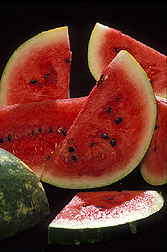This page has been archived and is being provided for reference purposes only. The page is no longer being updated, and therefore, links on the page may be invalid.
Watermelon's Power of Red—in Powder Form?
By Erin PeabodySeptember 15, 2006
There's no upstaging watermelon at a summer picnic. The much-loved fruit, with its juicy red flesh and seed-spitting fun, is also one of the best sources of lycopene around. Lycopene is a red-pigmented antioxidant thought to guard against heart disease and some cancers.
Now, a scientist with the Agricultural Research Service (ARS) has made it easier to access watermelon's impressive lycopene stores. Chemist Wayne Fish, who works at the ARS South Central Agricultural Research Laboratory in Lane, Okla., has discovered a way to gently extract the antioxidant from watermelon flesh and juice, ensuring it stays in its most natural form.
The resulting lycopene can be processed into a powder, paste or liquid suitable for use as a nutritional supplement or food coloring.
Right now, most lycopene formulations are made from tomatoes—that is, the copious juice, skins and fleshy residue left over after processing. But fresh watermelon—which actually contains more lycopene than fresh tomatoes, ounce for ounce—is an ideal source of the powerful antioxidant.
With Fish's method, growers would also have a potential new market for their imperfect melons. Each year U.S. watermelon growers must toss out 15 to 25 percent of their crop because the fruits don't make the grade. But despite their bruised, misshapen or discolored exteriors, these melons could be a valuable source of lycopene, since the fruit's outward appearance has no effect on its nutrient content.
According to Fish, the lycopene formulation he's discovered is unlike any currently available. That's because his extraction method respects the melon's cellular makeup.
In the fruits and vegetables it's found in, lycopene is naturally packaged in tiny structures called chromoplasts. Fish is careful not to injure these delicate organelles, or their thin, fragile membranes. He's found that lycopene left inside its protective membrane coat is more stable and boasts a longer shelf life.
Fish's novel method can also be used to tap the lycopene found in other fruits including tomatoes, guava, rosehips and pink grapefruit.
ARS is the U.S. Department of Agriculture's chief scientific research agency.

